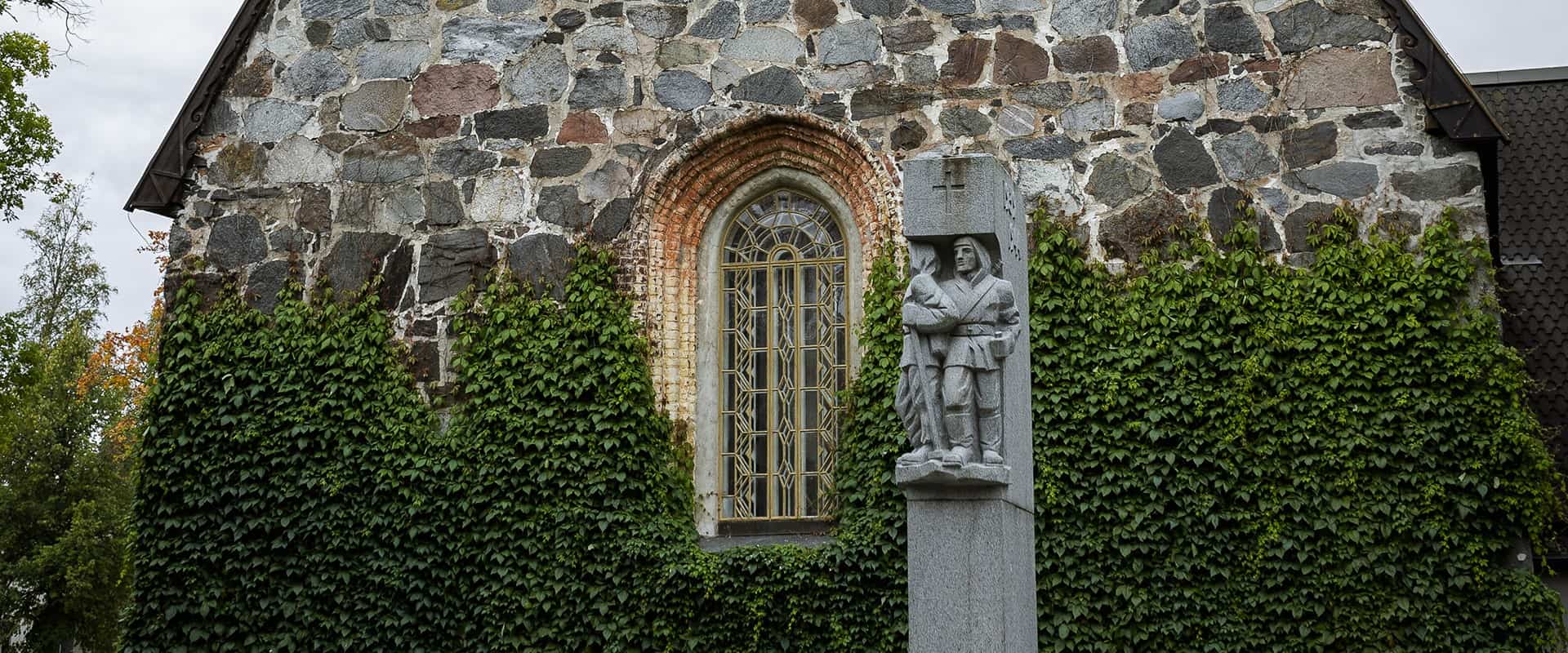History of Häme
Häme region has been inhabited since the Stone Age. The first written mention of the region is found in the Chronicle of Novgorod, in reference to a military campaign launched by Prince Vladimir in 1042. The region had been ruled by the Swedes since the late 13th century. In the 14th century, Häme became a fiefdom, whose administrative seat was Häme Castle, one of Finland’s medieval castles. Although the precise timeframe of the castle’s construction is not known, it was at least completed before the end of the 13th century, and is linked to the Second Crusade launched by the Swedes. The first written mention of the castle is from 1308. The castle played a crucial role as the administrative seat of Häme in the Middle Ages. When Finland was taken from Sweden by the Russians in 1809, Häme region also became part of the Russian Empire. Russian rule ended in 1917.
Ancient Häme
Häme region is located in the south-west part of the old, historical area of Häme. The area of Häme has been inhabited since the early Stone Age. People who lived in the area about 2000 years ago spoke a language that a modern inhabitant of Häme would be able to understand. The inhabited area, that can be considered the core area of Häme, was formed around Lake Vanajavesi. What has been regarded as a sign of organised cooperation between the inhabitants of the area are the ancient fortresses built on top of many hills that formed a clear line from south to north. One of the best-known of such defensive structures is Rapolanharju in Sääksmäki, but also Tenhola in Hattula, and Hakoinen in Janakkala were important fortresses. Villages often developed around the fortresses, and for example Hattula and Vanaja-Janakkala had their beginning this way. An old trade route known as the Ox Road of Häme connected Häme with the western coast of Finland. Soon the area along the road was inhabited and has continued to be so until today. The first signs of the arrival of Christianity to the area of Häme date back to the 11th century, and around the middle of the 13th century, a Swedish crusade made Häme part of the kingdom of Sweden.
Under the Swedish rule
Under the rule of Sweden, Häme region was part of the Häme fiefdom that was formed around the castle built in the area. Stable conditions and the rule of the crown in the area caused settlement to spread into the wilderness and to old hunting grounds. Various parts of the present Häme region became inhabited at that time, and the permanent settlement of both the south-western Häme as well as the area of Hausjärvi is believed to have taken place in the 14th and 15th centuries.
At the beginning of a new era, in the 16th century, the crown tightened its grasp of the region. Village settlements and farming were renewed by introducing the open field system, and the religious reformation weakened the traditionally strong power of the church. Silver items were removed from the churches and fewer stone churches were built. Small parishes, such as Renko, could not maintain their old stone churches. Increased population meant particularly an increase in the number of landless peasants, but at the same time, a new group was born at the top of the society, the non-noble gentry. Manor houses were built in various parts of Häme in the 17th century, but until the end of the 18th century, peasants mainly lived in chimneyless huts that had only one room. Due to the remote location of Häme Castle, the area had little significance as an administrative centre. For a long time, the town of Hämeenlinna, that was founded around the castle in 1638, remained a modest trading post whose remote location attracted neither the bourgeoisie nor the gentry. During the latter half of the 18th century, the town was relocated to its current location, but that, too, failed to increase its significance as a town. For the people of the area, however, the town was not only a trading place but a school town: as soon as Hämeenlinna was founded, a school with the lower grades of grammar school started its operation in the town.
The famine in the end of the 17th century and the Russian occupation at the beginning of the next century (1714-1721) made the area momentarily poorer, but the latter half of the century was characterised by a strong period of pioneering. General parcelling out of land was used in order to make farming more profitable. Ore and wood, the traditionally important raw materials of Sweden, were also obtained from Häme. Copper was mined in Tilasinvuori in Tammela for a short time in the 18th century, and already after the Russian occupation, a manor sawmill was established in Jokioinen. Most of the sawmill’s products were transported all the way to Stockholm. In addition to the sawmill industry, textile industry developed in the area. In 1763-75, a linen factory worked in Hämeenlinna, and in 1797 a cloth factory was founded in Jokioinen. This was the first machine operated factory in Finland. Häme was also one of the most significant linen producers in Finland. Flax was grown particularly in the area close to Lake Vanajavesi. For centuries, handicraft was the major source of income among the inhabitants of both the town and countryside, and the gradual population growth of Hämeenlinna was mostly based on the increased number of artisans.
The period of Russian rule
The end of the Swedish rule in 1809 had very little influence on the everyday life of the people of Häme. The journey that the Russian czar undertook from Turku to Tampere in autumn 1819 along the Ox Road of Häme and through Hämeenlinna strengthened the ties of the people of Häme with their new ruler. The old class society started to show signs of deteriorating, and peasants became more wealthy. The craftsman class prospered, and handicraft centers developed in many parishes, such as in Hauho. In addition, the development of industry gained new force. In 1818, Gustav Georg Nordenswan from Janakkala, Tervakoski, was granted a permission to manufacture paper which started the era of paper industry in the region. In 1838, Swede Axel Wilhelm Wahren rented the cloth factory in Jokioinen and after a few years he started a cotton spinning company in Loimijoki, Forssa. The mill was powered by the Kuhala stream. The first railroad in Finland was built from Helsinki to Hämeenlinna in 1862. The region’s location in the important “crossing point” of various traffic routes was further improved when, a few years later, a railroad was built from Riihimäki to St. Petersburg. A railroad was further built from Hämeenlinna to Tampere and when it was finally extended from Toijala to Turku, also the municipalities of south-western Finland could partake in the benefits of the new transportation vehicle.
The boom was momentarily interrupted when the great famine of 1867-68 severely taxed also the area of Häme. Great hordes of beggars journeying to the south wandered through the region. After the bad harvest years, farming methods were renewed with vigour and the living conditions of the population improved further. In addition, the general attitudes changed in the society and had their influence on the lives of the people of Häme. The status of Hämeenlinna as a school town was strengthened when the town’s grammar school was converted into a four-grade upper elementary school in 1843. An event of particular significance was the transfer of the Finnish-speaking classes of the normal school in Helsinki into Hämeenlinna in the 1870s. Thanks to the school, for the next decades Hämeenlinna was the centre of the rising Finnish culture. The classical lyceum of Hämeenlinna, the first Finnish-language grammar school, became the school attended by many important persons in science and arts. Also, the industrialisation and urbanisation caused changes to take place in the everyday lives of people everywhere, the power of the church decreased, and the new leisure activities increased union activities, in addition, newspapers and other phenomena of the time spread to the countryside.
The new ideas and customs also brought about new political ideas, and the turn of the century increased restless movements also in Häme. The First World War brought large Russian garrisons into the area. The prolonged war increased poverty and lack of foodstuffs and caused tension. In 1917 the situation culminated when the news of the defeat of the czar and the overthrowing of the Russian government spread into the area. The tragic events that took place in Mommila, Lammi, and the murder of Alfred Kordelin shocked the entire country. Even the declaration of independence in December 1917 failed to calm things down. The armed conflict in various parts of the country in 1918 had tragic consequences for Häme, and the war with its aftermath left deep marks in the people of the region.
An independent country, an independent region
After the war, the changes in society continued at an increased rate. The source of livelihood for the majority of people was still farming, although more and more people moved into towns every year. The cotton industry in Forssa, the sawmills, glass factory, and arms and technology industry in Riihimäki made those areas the most important industrial centres of the region. Hämeenlinna remained a town of administration and education, although industrial activities were increasing there as well. The living conditions of the people improved, and electricity and telephone became available to more and more people. The traffic between different areas improved further when cars entered the roads, transporting people and things easily also outside the waterways and railways.
The Second World War had an intense influence on Häme. The sacrifices on the front and the bombing of the region left their marks in the lives of the people. The restructuring after the war and the settling of the people evacuated from Karelia changed the look and the structure of the region. The building of main roads and highways and the improved traffic connections further increased the connections that the area had with southern Finland. When Riihimäki became a town in 1960, and Forssa followed its example a few years later, the region started to form around three towns. Hämeenlinna has remained a town of administration and education, even though industrialisation was strong in the 20th century. An important characteristic of Riihimäki is its location at the “crossing point” of various traffic routes. The town that developed on the crossing point of railroads works in close cooperation with Hyvinkää, part of the Uusimaa region, and both towns greatly benefit from the vicinity of the capital in terms of both employment and population policy. The textile industry was the most significant employer in Forssa until the 1970s. Today, the area of Forssa is best known for its food industry. In 1997, when changes were made in local administration, Häme region was formed into the area that had always belonged to the county of Häme, and that included the historically oldest core of the ancient Häme.
References:
Saarenheimo Juhani
Kun toimeen tartuttiin, Hämeen historia vuoteen 1945 [History of Häme until 1945], Hämeenlinna 1984
Rasila Viljo
Häme Ennen ja Nyt, Kaikuja Hämeestä [Häme Now and Before]. Ed. Jari
Alenius, Lari Ahokas, Jarmo Koskela, SKS, Helsinki 2003, Ojanen Eero
Linnavuoret Hämäläisessä maisemassa, Kaikuja Hämeestä [Fortsesses in Häme]. Eds. Jari Alenius, Lari Ahokas, Jarmo Koskela, SKS, Helsinki 2003
Rasila Viljo
Hämeen rajat, Kulta Häme, Hämeenmaa XVIII, Hämeen heimoliitto ry. Ed. Jukka Peltovirta,
Peltovuori Risto
Forssan historia [History of Forssa], Forssa 1993, p. 15;
Keskitalo Oiva, Hausjärven historia [History of Hausjärvi], Hämeenlinna, 1964
Hämeen Härkätiellä [On the Ox Road of Häme], ed. Pirjo Poutanen, Keuruu 2002,
Nenonen Marko
Moottoritie Tampereelle [Highway to Tampere], 2000

